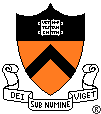
|
Computer Science 425
Database & Information Management Systems
Andrea LaPaugh
|
Fall 2006
|
Directory
General Information |
Schedule and Readings
| Project Page
|
Announcements
Course Summary
This course studies systems for
accessing, searching, and managing
information. We examine in detail the methods employed by
database systems to manage structured data. We also
consider the organization and search of collections of semi-structured
and unstructured information such as the Web and digital libraries,
considering both the application of database concepts and new
models. Correctness, performance, and system requirements
are considered throughout. Some specific topics: the relational
data model; the XML model; indexing; query construction and evaluation;
transactions; search effectiveness.
Prerequisites
COS 217 and 226.
Administrative Information
Meeting time: Mon., Wed., 1:30-2:50 pm
Meeting place: Friend Center 004
Extra meetings: If a class should be canceled, a make-up class
will be scheduled during reading
period and/or in the evening during the semester. Class participants
will
be consulted before any make-up class time is chosen.
Professor: Andrea
LaPaugh, 304 CS Building, 258-4568,
aslp@cs.princeton.edu,
Office hours: Mondays 3-4pm or by appointment
Course secretary: Mitra Kelly, 323 CS building, 258-4562,
mkelly@cs.princeton.edu
Reading
Required text: Raghu Ramakrishnan and Johannes Gehrke,
Database
Management Systems, Third Edition, McGraw-Hill, 2003.
Supplemental reading on reserve at Engineering Library
- Abraham Silberschatz,
Henry Korth, and S. Sudarshan, Database System
Concepts, Fifth Edition, McGraw-Hill, 2006. Note that this
newest edition has a substantial amount of new material, particularly
on applications and XML.
- Ramez Elmasri and Shamkant Navathe, Fundamentals of Database
Systems, Addison-Wesley, Fourth Edition, 2004 or Fifth Edition, 2006.
- Ricardo Baeza-Yates and Berthier Ribeiro-Neto, Modern Information Retrieval,
Addison-Wesley, 1999.
- Soumen Chakrabarti, Mining
the Web: Discovering Knowledge from Hypertext Data, Elsevier
(Morgan_Kaufmann Division), 2003.
Communication
Assignments will be
made available through the Schedule
and Readings page of the course Web site. ``Handouts'' and copies
of any
transparencies
used in class will be posted on the course Web site with links from the
Schedule
and Readings page. Important
announcements on all aspects of the course will be made on the Announcements page.
Students are responsible for monitoring the Schedule
and Readings and Announcements
pages. Schedule changes will be made on the
Schedule
and Readings page and announced on Announcements
page.
You are encouraged to use electronic mail to set up appointments,
leave
messages, and ask quick questions (like ``What was that reference you
gave
today in class?'' or ``I've been at McCosh Infirmary all week; can I
have
an extension on my assignment?'') However, an old fashioned
face-to-face
meeting is still best for clarifying confusions and other technical
discussions.
Work of the Course
The course will have the following components weighted as indicated:
- Problem sets 25%
- Midterm Exam 20%
- Second Exam 20%
- Design Project 30%
- Class Participation 5%
Problem sets
There will be 6 problem sets distributed throughout the semester.
Most
will be written work, although you may be asked to write a few short
programs.
Exams
There will be two take-home exams, each of equal weight. Each
exam covers the material
of roughly one half of the semester.
Project
Each student will do a final project of his or her choosing related to
the material of the course.
This project may be done in pairs. The project must be approved in
advance by the course instructor.
See the project page for more
information and a list of suggested projects.
A.S. LaPaugh Thu Oct 5 16:35:00 EDT 2006

